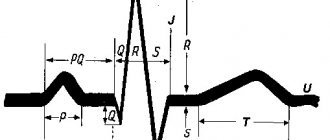No pregnant woman is immune from various complications. She can learn about them at different times in her “interesting” position. One of these diagnoses that darkens the mood of the expectant mother may be low placentation. What is it, is it possible to recognize this condition before an ultrasound scan, what to do to maintain pregnancy and how the birth will proceed - we will give answers to these questions.
What is low placentation?
The placenta is an organ necessary for the development and successful gestation of the fetus. It is formed in the uterus. Through the circulatory system of the placenta, the embryo receives nutrients and oxygen. When is the placenta formed? The initial stage of this process begins closer to the seventh day after conception. During this period, the placenta precursor, the outer membrane, develops around the fetus. The process of its formation is completed by the 20th week of pregnancy. The course of pregnancy and childbirth depends on the placenta’s attachment to the wall of the uterus. Ideally, the placenta is attached at the highest point inside the uterus: there are better conditions for the development of the embryo and excellent blood flow. But often a pregnant woman is diagnosed with a low-lying placenta. This is low placentation. In this condition, the embryo is attached closer to the exit of the uterus (throat) closer than 5.5-6 cm.
Among the reasons influencing the rates of maternal (MC) and perinatal mortality (PM), it should be noted anomalies of the placenta (AP), which include placenta previa (PP) and low placental attachment (LP) [1-3, 10, 15, 17, 22, 23, 31, 38, 40-42, 47, 49, 50, 54, 58].
With ARP, chronic fetoplacental insufficiency (FPI) develops, caused by relatively low vascularization in the lower parts of the uterus compared to its body and fundus. In this case, a decrease in blood supply to the placenta and fetus, limitation of gas exchange and metabolism in the fetoplacental complex (FPC), impaired maturation of the placenta, decreased synthesis and imbalance of placental hormones and their precursors of maternal and fetal origin are often observed. All these pathological changes reduce the compensatory and adaptive capabilities of the mother-placenta-fetus system, lead to delayed development of the fetus, and cause a complicated course of pregnancy and childbirth (threat of premature termination of pregnancy and premature birth - birth defects, labor abnormalities, premature placental abruption) [3, 5, 7, 20, 27, 28, 32, 34, 35, 37, 56].
The location of the placenta in the lower segment is a relatively common pathology. In the first trimester it can reach 30%, by childbirth the number of cases of PP ranges from 0.3 to 1.04%, NP occurs in 9.1% [2, 3, 23, 31, 74]. PS with ARP reaches 22.2-81‰ [1, 3, 7, 13, 14, 18, 33, 37]. Maternal morbidity in PP is up to 23% [1-4, 12, 22, 23, 26, 31, 41, 45].
A number of studies have been devoted to studying the issues of placenta previa and low attachment [17, 22, 28, 33, 38, 39, 53, 59]. However, many aspects of the etiology, pathogenesis, characteristics of pregnancy, childbirth, the state of the fetoplacental system and fetus, and methods of delivery in ARP have not been sufficiently studied. The fact that PP and NP occur more often in multipregnant women, especially in those who have had many abortions, indicates the influence of inflammatory processes in the uterus on the occurrence of this pathology, leading to abnormal implantation of the fertilized egg [17, 28, 32].
The main complication of pregnancy and childbirth during PN and PN is bleeding, which is of a massive obstetric nature. Bleeding can occur at different stages of pregnancy. As pregnancy progresses, the likelihood of bleeding increases [1, 2, 6, 9, 12, 25, 42, 44, 57]. In 66.6% of cases, bleeding is observed with incomplete PP and in 33.4% with complete presentation. It is known that the type of PP affects the nature of bleeding [3, 36, 38]. Thus, with incomplete PP, bleeding occurs in the third trimester of pregnancy or during childbirth; with complete PP, bleeding begins early, often in the 2nd trimester of pregnancy. Sometimes bleeding occurs in the first trimester, when the placenta previa causes a miscarriage. An increase in bleeding was noted in the last 2 weeks of pregnancy, when a complex and diverse restructuring occurs in a woman’s body aimed at ensuring labor [1, 3, 4, 38, 43]. In this case, placental abruption begins from the walls of the uterus due to stretching of the lower segment during pregnancy, and then during childbirth when the cervix is smoothed and the uterine os opens. The severity of bleeding with complete placenta previa is usually greater than with partial placenta previa. Bleeding often begins spontaneously, without any reason, and can be moderate or profuse. Shock blood pressure levels are observed in 58% of cases. In the structure of MS, bleeding remains one of the main causes, among which the 4th place in frequency is occupied by bleeding associated with PP [31, 48, 52, 58]. D. Bick [50] notes a significant increase in the frequency of antepartum hemorrhages, placental abruption, blood transfusions, and cesarean sections during PN. He also points to a 4-fold increase in vaginal births and a 2.5-fold increase in the length of stay of postpartum women in the hospital during NP, although he denies the influence of this pathology on the incidence of premature births.
The course of pregnancy with ARP is often complicated by the clinical picture of the threat of miscarriage, while the nature of the symptoms is determined by the duration of pregnancy and depends on the location of the placenta (anterior or posterior wall of the uterus) [22, 38]. A threatened abortion can be the background against which PP and NP are formed, and, conversely, branched chorion presentation can be the cause of termination of pregnancy.
In the first trimester of pregnancy, with NP of the placenta and its localization on the anterior wall of the uterus, pain in the lower abdomen and lower back most often appears (35.9 and 14.3%, respectively). When the placenta forms on the posterior wall of the uterus, the leading symptom is blood discharge from the genital tract, combined with a pain symptom (22.4 and 16.5%, respectively). In the second trimester, the number of cases of threatened miscarriage decreases, but remains higher when the placenta is located on the anterior wall of the uterus (46.5%), while pain symptoms are more often observed (18.4%), and bleeding from the genital tract occurs somewhat less frequently (9.7%) [17, 33]. In the third trimester, the frequency of complicated pregnancy when the placenta is localized on the anterior wall of the uterus is reduced by 2 times compared to that in the second trimester. When the placenta is located on the posterior wall of the uterus, the incidence of complications increases.
With NP of the placenta, not only does the excitability of the myometrium increase, but also the coordinated nature of its contractions is disrupted, which leads to placental abruption [17]. According to some authors [1, 3, 38], greater activity of the uterus when the placenta is localized in the lower segment is associated with the absence of a “progesterone block” of the placental site in the body of the uterus.
However, there is an opinion that termination of pregnancy is not associated with ARP [32]. A. Wexler and K. Gottersfeld (1977) even consider PP to be a variant of the norm. It has been proven that with ARP there is a deficit in circulating blood volume (CBV) due to a decrease in plasma and globular volumes. Consequently, this leads to the development of hypotensive syndrome, which occurs in 1/3-1/4 pregnant women [2, 3, 27, 38]. It is known that placental NP can prevent the development of arterial hypertension during pregnancy. There are reports of features of the development of early toxicosis and gestosis in pregnant women with PP [28]. Early toxicosis was noted in 38% of women (no more often than with normal placentation), gestosis - in 8.6%, mainly in the form of hydrops of pregnant women.
Progressive anemia due to repeated bleeding is a characteristic feature of this pathology. The hemoglobin level varies within 105 g/l, despite the therapy [2, 3, 30].
ARP is one of the high risk factors for the development of postpartum diseases and PS [2, 3] and accounts for 17-26%. Fetal death is associated not with the number of bleedings, but with the amount of blood loss [20]. A number of studies indicate that with PP, abnormal position of the fetus is often observed. The presenting part of the placenta interferes with the correct insertion of the head and pelvic end, which deviate away from the longitudinal axis of the uterus [2, 3, 45]. Breech presentation occurs in 16.4% of cases, transverse position - in 16.8% [1, 2, 45]. However, in the work of R. Deter (1993) such a dependence is denied.
The management of pregnancy and childbirth during PP is determined by the duration of pregnancy, the presence of bleeding and its intensity [1, 3, 5, 38].
In the absence of bleeding in the second trimester of pregnancy with PP, confirmed by ultrasound, the pregnant woman is observed in the antenatal clinic. In this case, the patient is managed according to generally accepted principles of observation, but with a mandatory assessment of hemostasis and an ultrasound scan after 3-4 weeks to assess the possibility of placental migration. The patient is advised to avoid physical activity, long trips, and limit sex life. If blood discharge appears from the genital tract, a woman needs hospitalization. Subsequent management tactics will be determined by the location of the placenta and the amount of blood loss [2, 3, 38]. With minor bleeding from the genital tract, therapy aimed at prolonging pregnancy is possible, and massive blood loss is the basis for a minor cesarean section [3, 38]. Conservation therapy (bed rest, antispasmodics, etc.) is carried out under the control of hemostasis [43]. According to indications, fresh frozen plasma is administered, antiplatelet agents (curantil, trental) are used, the hemostatic system is activated and therapy is aimed at improving microcirculation (dicinon) with the addition of antianemic drugs. Ultrasound monitoring of the degree of ARP detachment is mandatory [3].
In the third trimester of pregnancy with PP and in the absence of bleeding, the issue of hospitalization is decided individually. If the patient’s place of residence is not far from the maternity hospital and it is possible to get to it in 5-10 minutes, it is possible for the patient to remain at home until 33-34 weeks. If the place of residence is more distant, it is advisable to hospitalize the patient in a hospital. The presence of heavy bleeding is an indication for emergency surgical delivery, regardless of the stage of pregnancy [3, 6, 57, 58]. In the absence of blood discharge from the genital tract, it is possible to prolong pregnancy until 37-38 weeks, followed by surgical delivery. During cesarean section, especially when the placenta is located on the anterior wall of the uterus, massive bleeding may develop, which is associated with the presence of the placental site and impaired contractility of the uterus (lower segment) or with dense attachment or placenta accreta [21, 24, 39-41] . Developed massive bleeding is the basis for expanding the scope of surgical intervention (ligation of the great vessels, ligation of the internal iliac arteries, hysterectomy). In the works of some domestic authors, when identifying placenta accreta or dense attachment, the need for preventive isolation of the internal iliac arteries is indicated before performing a cesarean section and involving a vascular surgeon in this stage of the operation [3, 8, 39]. In this regard, patients with complete PP need color Doppler mapping before surgery to clarify the degree of invasion of placental villi into the uterine tissue and select further tactics for managing these patients [3, 16]. According to some authors, if the placenta is predominantly localized on the anterior wall of the uterus, it is possible to perform a corporal cesarean section to avoid additional blood loss [3, 24, 38, 41, 45]. In a multidisciplinary hospital and the presence of an angiographic installation to stop bleeding, embolization of the uterine arteries is possible, allowing organ-saving surgery to be performed [3, 8, 19, 25, 30, 39, 46]. In case of NP of the placenta in the absence of bleeding with the onset of labor, it is possible to conduct labor through the vaginal birth canal with early amniotomy, which helps prevent placental abruption due to pressing of the edge of the placenta by the presenting head [3, 6, 38]. The appearance of blood discharge from the genital tract is the basis for surgical delivery.
In the works of modern authors, based on a study of the anamnesis of mothers and the nature of disorders of the respiratory function of fetal blood, two types of development of oxygen starvation in the fetus are indicated: chronic and acute hypoxia [5, 35, 38]. The authors believe that in PP the mechanism of hypoxia development is associated with oxygen starvation of the mother due to anemia and placental insufficiency (PI) [5, 35, 38]. Chronic PN occurs in every 3rd pregnant woman at high risk of developing perinatal pathology. Acute PN occurs as a consequence of extensive placental infarctions and placental abruption [1, 3, 4, 7, 16, 37].
Fetal hypoxia can lead to both hypoxic-ischemic and hemorrhagic brain damage. In the pathogenesis of CNS damage in the fetus and newborn associated with hypoxemia, ischemia and asphyxia, biochemical and biophysical aspects are distinguished [3, 13, 29, 55, 56]. With asphyxia, hypercapnia develops, leading to an increase in cerebral blood flow, as well as a decrease in metabolism in the brain. The progression of asphyxia leads to the development of tissue acidosis and damaging effects on brain tissue. Thus, the hypoxic effect is based on a violation of energy metabolism, which follows the path of anaerobic glycolysis with the formation of lactate [5]. Morphologically, hypoxic brain damage in premature infants manifests itself in the form of peri- and intraventricular hemorrhages and periventricular leukomalacia, in full-term infants - in the form of cerebral edema, necrosis of gray matter and parasagittal ischemic damage.
One of the most common forms of fetal pathology with ARP is intrauterine growth restriction syndrome (IUGR). According to some authors, the number of cases of FGR among full-term infants ranges from 2.9 to 41.8%, among premature infants - from 18 to 33% [20, 37]. However, M. Levene et al. [56] note quite satisfactory long-term results. A. Israel et al. [55]. This fact is confirmed in the works of V.G. Anastaseva [5], I.S. Sidorova [39], who indicate that with FGR of the fetus, thinning of the placenta up to 20 mm is observed. At the same time, P. Wexler (1977) denies the influence of the location of the placenta on the condition of the fetus, noting that the placenta in this case is functionally more active than with its usual localization, therefore, with large PP, FGR of the fetus is not observed.
Among children born to women with PP, there is a high proportion of premature babies, and it is this contingent that makes up 50-60% of all dead and stillborn children [1, 7, 18]. Survivors often have pulmonary dysplasia, abnormalities in the neurological status in the form of congenital and post-traumatic hydrocephalus, spastic paralysis, hearing loss and visual impairment such as retrolental fibroplasia [13, 18, 20]. R. Deter et al. (1998) consider significant an increase in the number of birth defects, the birth of children with low body weight and malnutrition, and a high level of PS in cases of birth defects. The authors deny the more frequent birth of children with developmental defects.
Thus, ARP poses a great danger not only for the woman, but also for the fetus (newborn). The fetus develops anemia, against the background of which damage to the central nervous system may occur, clinically evident in the postnatal period. With massive blood loss in the mother, children are born in a state of adynamia, anemia, and shock [7, 13, 17, 20, 37]. Chronic fetal hypoxia is observed with anemia that develops in pregnant women against the background of recurrent bleeding. At the same time, the fetus’s adaptive capabilities decrease during the transition from intrauterine to independent existence; after birth, its reserve capabilities are rapidly depleted, which most often manifests itself in the form of secondary asphyxia [2, 3, 11, 13, 20, 30]. Chronic intrauterine hypoxia and FGR are observed in 18-20% of cases [37]. In turn, FGR reduces the fetus’s resistance to oxygen starvation and contributes to the occurrence of asphyxia and intracranial injury. During the first year of life, most of these children have a tendency to acute respiratory diseases, rickets, etc. [20, 30].
Thus, the increase in the frequency of premature termination of pregnancy with ARP can be considered reliable. Despite a number of disagreements, most authors adhere to this point of view. There is no such consensus of opinion regarding other ante- and postnatal complications for the fetus, which is due to different criteria for selecting the study population, different research methods, or a small number of observations. Some studies have not identified the degree of PN depending on the type of abnormal placental attachment; the relationship between the degree of fetal growth retardation and the severity of fetal impairment during pregnancy is not reflected, which is due to the insufficiently high information content of echography. To obtain a more accurate picture of the condition of the fetus in cases of presentation, low position, and also in cases of placental migration, comprehensive dynamic monitoring of fetal growth during pregnancy is necessary using modern research methods (Dopplerometry, cardiotocography).
The etiology and mechanism of occurrence of ARP remain not entirely clear to date. Traditionally, among the causes of placenta previa, a distinction is made between maternal factors and factors caused by placental pathology. Maternal factors include a large number of births in the anamnesis (complete PP is observed in approximately 80% of multiparous women, and partial presentation is more often detected in primiparous women and in pregnant women over 35 years of age, regardless of the number of births in the anamnesis).
Factors caused by the pathology of the placenta (as a consequence of improper implantation of the embryo) are considered in two groups of theories:
— theories that explain the development of PP by the failure of the fertilized egg itself;
— theories that make the occurrence of PP dependent on the anatomical and physiological characteristics of the uterus [22, 28]. Moreover, the latter are considered leading.
1. Impaired vascularization of the decidua caused by atrophic changes or an inflammatory process. During inflammatory processes, the ciliated cilia of the uterus die, the folding of the mucous membrane disappears, and the amount of its secretion increases. At the end of the proliferation phase (at the time of ovulation), the uterine cavity is replete with secretory fluid. The fertilized egg is not able to quickly melt the layer of secretion and implant in the bottom, so it slides down in the flow of secretion due to gravity, where implantation occurs. The fertilized egg, like a tree growing on depleted soil, spreads deep and downward through the chorionic villi [28].
2. Scar changes in the endometrium caused by repeated pregnancies.
3. Impaired blood supply, changes in the endometrium due to previous surgical interventions in the lower segment of the uterus (myomectomy, cesarean section, hysterotomy), requiring a larger surface area for the placenta to attach.
4. An increase in the surface of the placenta during multiple pregnancy, leading to the fact that the lower edge of the placenta reaches the area of the internal os.
5. Erythroblastosis fetalis, causing enlargement of the placenta.
ARP is also caused by congestion in the pelvis, caused by various somatic pathologies, which disrupts the conditions for the development of the fertilized egg [28].
Some authors note smoking as a significant risk factor for the occurrence of PP [51]. They believe that hypoxemia causes placental hypertrophy. When a woman smokes 20 cigarettes a day, the frequency of placenta previa increases by 2 times compared to that of non-smokers. The same authors identified a connection between placenta previa and cocaine use [51].
Thus, PP has a polyetiological origin, and therefore the reasons for low placentation remain controversial. According to the literature [28], the endomyometrial factor is the main factor in the genesis of NP. However, it has been noted that the number of abortions does not affect the degree of risk of this type of pathology. This theory also does not explain cases of PP in primigravid women. A.A. Milovanov [26] emphasizes the importance of heredity in the development of ARP.
The morphogenesis of the placenta depends on the development of the uteroplacental circulatory system. According to morphological studies [29, 33], from the 16th to 18th day after implantation of the fertilized egg, the process of invasion of interstitial cytotrophoblast is observed. At the 5-6th week, the invasion processes become most intense (the first wave of invasion), causing the appearance of cytotrophoblast cells in the lumen of the endometrial segments of the spiral arteries. This promotes the expansion and opening of the spiral arteries into the intervillous space, ensuring the initiation and progressive growth of the uteroplacental complex (UPC).
At the 16-18th week of pregnancy, the second wave of cytotrophoblast invasion begins due to the migration of intravascular cytotrophoblast cells deep into the walls of the myometrial segments of the spiral arteries, which is accompanied by the destruction of the elastomeric components of the vessels and their replacement with fibrinoid. As a result of the almost complete destruction of the muscular elements of the endo- and myometrial segments of the spiral arteries, a significant expansion of their lumen and the disappearance of the response to the influence of vasopressor factors occur, which ensures a further increase in uteroplacental blood flow. The changes occurring in the walls of the spiral arteries should be considered as an adaptive physiological process aimed at ensuring continuous adequate blood flow to the intervillous space [28, 32].
With ARP, vascularization of the subplacental zone is reduced. The thinner wall of the lower segment of the uterus does not provide the necessary conditions for sufficient vascularization of the placental bed and gestational restructuring of the myometrial segments of the spiral arteries. Hypovolemia and arterial hypotension play an important role in reducing blood flow into the intervillous space [28, 32].
A decrease in the vascularization of the BMD has a serious impact on the formation of FPN due to the fact that the level of gas exchange is determined to a greater extent by the speed of blood flow than by the diffusion properties of the placenta. Slowing blood flow in the spiral arteries and intervillous space invariably leads to a decrease in gas exchange between maternal and fetal blood [5, 28, 35].
Significant differences (more than 50 times) between the level of location of the placenta in the first trimester and at the time of delivery had to be explained. The first attempt of this kind was made by K. Schlensker [4, 30], who described the so-called “migration” of the placenta, i.e. changes in the localization of the placenta during pregnancy. The direction of placental displacement in all observations is the same - from the lower segment to the fundus of the uterus [4, 5, 17, 22, 28].
There is no consensus in determining the low location of the placenta, N. Schlenske [cit. according to 4] considers low attachment when the edge of the placenta does not reach the internal os by 10 cm. Most authors are of the opinion that low placentation is a condition in which the distance from the edge of the placenta to the internal os is less than 7 cm [2, 3]. Different definitions of the concept of “low placentation” and possible diagnostic errors lead to a significant discrepancy in the reported frequency of ARP. The classification of I.S. is widely used. Sidorova: the interpretation of the concept of “low placentation” depends on the duration of pregnancy: up to 16 weeks - up to 2 cm from the internal os; 17-24 weeks - up to 3 cm; 24-28 weeks - up to 4 cm; after 28 weeks - up to 5-6 cm [37].
Some authors explain the phenomenon of migration by the formation of the lower segment of the uterus through muscle growth and stretching of this area, as well as simultaneous thinning, atrophy, partial rejection and repeated nidation of the villi of the edge of the placenta [28]; other authors [22] - by “searching” by the villi for more favorable places than the lower parts of the uterus (isthmus - lower segment) to provide the necessary nutrition to the fetal egg. The process of placental migration is influenced by the state of the isthmic-cervical section of the uterus: anatomical and functional insufficiency and infection of this section reduce elasticity and, increasing tension, accelerate migration, causing violent pathological symptoms. On the contrary, excessive density of this section increases elasticity and, by reducing tension, slows down migration.
Thus, sclerosis of the isthmic-cervical part of the uterus and tight attachment of the placenta determine the persistence of PP.
The myometrium in the area of the cervix and isthmus of the uterus is largely represented by the inner layer (the so-called silent zone) [28], which has weak contractile activity and reflects the state of the FPC, in particular its readiness for childbirth. The arrangement of smooth muscle bundles in the area of the isthmus and anterior wall of the uterus is looser, which causes greater stretching of the isthmus and supravaginal part of the cervix during the formation of the lower segment [22, 28]. This explains the fact that the placenta previa, located on the anterior wall of the uterus, moves much more often and faster than on the posterior wall [22, 28, 37].
With an intact isthmic-cervical uterus, migration of the placenta previa is a consequence of the development of the uterus and placenta during pregnancy. Pathology occurs with isthmic-cervical insufficiency (ICI), infection, sclerosis. In 27% of women, migration is asymptomatic, in the remaining 73% - with pathological symptoms: anemia, premature rupture of membranes, abnormal placental structure. Rapid migration is due to primary ICI, moderate migration is due to secondary insufficiency of the isthmic-cervical region when it is stretched due to an increase in the tone or volume of the uterus. Slow migration is observed with normal condition and density of the isthmic-cervical region.
With rapid migration of the placenta [3, 28], the dominant symptom is bleeding, the outcome for the fetus is extremely unfavorable: miscarriages account for 43.7%, PS - 16.7‰. With moderate migration, pain in the lower abdomen dominates, the number of miscarriages is 5.8%, PS is 9.4‰. Slow migration is almost asymptomatic, and no cases of fetal death have been observed. However, these studies do not provide an assessment of the function of the placenta during its migration, the condition of the fetus and newborn.
Thus, in the above studies of domestic and foreign authors there are no results of complex clinical, laboratory and special studies of the functional state of the placenta, on the basis of which one could draw a conclusion about the occurrence of PN during placental migration.
Causes of low placental attachment
Why is the placenta low? There are many reasons. Conventionally, they are divided into congenital and acquired - due to previous illnesses, operations, abortions. Reasons for low placental attachment include:
- anomaly in the development of the internal genital organs of a woman;
- age over 30 years;
- inflammatory diseases of the uterine mucosa and pelvic organs;
- presence of sexually transmitted diseases;
- previous surgeries on the reproductive organs;
- neoplasms in the uterus;
- multiple pregnancy;
- a large number of births;
- childbirth with bleeding and separation of the placenta;
- artificial termination of pregnancy (abortion)
Causes
The reasons that cause placenta previa are divided into the following groups:
- caused by the general condition of the pregnant woman;
- due to the characteristics of the fetus.
In the first case, when the pathology is caused by the general condition of the woman, the most common reasons include the following:
- Operations that the pregnant woman has previously undergone (uterine curettage, fibroid removal, cesarean section).
- Endometrial pathology.
- The woman had several births with complications.
You can also consider factors such as the presence of uterine fibroids or endometriosis, congenital anomalies of the structure of the uterus, pregnancies with multiple pregnancies, and endocervicitis. The risk of placenta previa increases with each subsequent birth.
When considering the second case, when the pathology of the placenta is caused by the characteristics of the fetus, specific processes can be indicated. For example, this may be a problem with normal troboblast implantation if enzymatic processes do not appear in a timely manner, and the process of attachment of the fertilized egg is disrupted. This point should be considered only when the embryo descends to the lower part of the uterus.
The danger of low placentation for pregnancy
If the placenta is descended, the fetus puts pressure on it as it grows. This can lead to bleeding and placental abruption. The latter is a serious threat not only to the life of the unborn baby, but also to the life of the pregnant woman.
Another thing low placentation threatens is the threat of miscarriage and other complications. As the fetus grows, the placenta moves. With low placentation along the anterior wall, it is possible that the umbilical cord may become entangled and the exit from the uterus may be blocked.
If a pregnant woman has low placentation along the posterior wall, there may be more complications. Subjectively, a woman may feel pressure in the lower abdomen and complain of pain, which will intensify as the fetus grows. Since there are few blood vessels in the lower part of the uterus, due to a prolapsed placenta, the fetus may not receive enough oxygen and nutrients.
Symptoms of low placenta previa during pregnancy
This pathology does not have any specific external signs. Low placentarity is manifested by the following symptoms:
- Bleeding. Already at 12-13 weeks, women with this anomaly may begin to experience uterine discharge mixed with blood, which is associated with microdetachments of the “baby spot” from the endometrium. Most often, this symptom manifests itself in the last trimester of pregnancy, when the fetus grows to a large size and, with movements, more strongly tears the placenta from the uterus. In the later stages, even a slight stress (coughing, orgasm, sneezing, constipation, etc.) can lead to heavy bleeding, threatening the life of the mother and her child. Due to periodic or constant blood loss, women often experience symptoms of anemia - dizziness, weakness, low blood pressure and hemoglobin levels in the blood.
- High position of the uterine fundus. Based on the location of the upper part of the uterus, the doctor usually judges the degree of development of pregnancy. With placental presentation, the uterine fundus is often located too high, which may indirectly indicate a low location of the placenta.
- Fetal presentation. The location of the baby, uterus and placenta are interdependent. Therefore, pelvic or transverse presentation of the fetus is often accompanied by a low localization of the “baby spot,” which the doctor can judge from the data obtained during an ultrasound examination of the patient.
Often this pathology (especially in the early stages) is completely asymptomatic. The woman may not feel pain or discomfort in the lower abdomen, and she does not have periodic or constant bleeding. Therefore, it is possible to unambiguously identify low placenta previa only with the help of modern diagnostic tools during routine gynecological examinations. Ultrasound is most effective in this regard. This method has the following advantages:
- Minimally invasive. If low placenta previa is suspected, an ultrasound examination is performed abdominally. The scanner is located on the outer surface of the abdomen; the doctor does not make any incisions, so ultrasound does not create any risks for the child or mother.
- Information content. Modern ultrasound machines have high resolution and accurately visualize the position of the baby in the uterus. With their help, the doctor can determine the location of the placenta, the distance from its edge to the uterine os.
If low placental capacity is suspected, your doctor may order an unscheduled scan to monitor placental migration. The procedure is usually performed at 12, 20 and 30 weeks of pregnancy, but more frequent ultrasounds are also possible.
A gynecological examination, which is standard during normal pregnancy, is not performed with this pathology. This is due to the fact that inserting instruments into the vagina can cause strong contractions of the uterus, which will result in premature labor with extensive bleeding.
Take the first step
make an appointment with a doctor!
Central (complete) placenta previa
This is a more serious diagnosis than low placentation in pregnant women.
With central presentation, the placenta is located at the bottom of the uterus, blocking the exit from it. There is also partial presentation - marginal and lateral. In the first case, the placental tissue covers two-thirds of the exit from the uterus, in the second - no more than a third of its pharynx. In case of central placenta previa, delivery is carried out by caesarean section.
Treatment for low placenta
There is no treatment for this condition. There are only guidelines to follow. In any case, it is better to take care of yourself and your unborn baby. With low placentation you need:
- exclude serious physical activity;
- get enough sleep and plenty of rest;
- eat right so that the child receives the right amount of vitamins;
- consult a doctor if something bothers you;
- stay calm;
- when sleeping, place a pillow under your feet - they should be above the level of the pelvis;
- temporarily give up intimate life;
- go to the hospital if the placenta has not risen by 36 weeks.
Rules of conduct and treatment
When you hear a diagnosis of “low placentation” from your attending physician, you should not panic. Firstly, panic is prohibited in any trimester of pregnancy, be it the 20th, 21st, 22nd, 23rd or 35th week. And secondly, this illness does not mean at all that the situation is dangerous and the pregnancy is doomed. This condition, depending on the distance between the placenta and the uterine os, is not always considered a pathology, but rather a borderline location of the fetus. The expectant mother will help herself if she follows some rules that the doctor will definitely tell her about:
- Avoid any physical activity, even if it is gymnastics for pregnant women. Do not make sudden movements, do not run or jump. Yes, physical activity in any trimester of pregnancy is desirable, but here we are talking more about normal gestation. It is especially dangerous to suddenly raise your arms up.
- Complete sexual rest, even if in the early stages of pregnancy sexual activity was allowed due to the absence of a threat to the child.
- Traveling in any public transport should be minimal; it is advisable to use a taxi or a personal car.
- Try to raise your legs while lying down or sitting, placing a pillow under them.
- It is imperative to call a doctor or even an ambulance at the first signs of bleeding, even before 20 weeks; a delay in this case is dangerous.
- If the treating gynecologist suggests hospitalization, you should not refuse it. Under the supervision of a doctor, maintaining a stable condition of the fetus with low placentation will be much easier.
These same tips, as a rule, are contained in any forum about pregnancy. As for the treatment of low-type placentation during pregnancy, like 20-25 weeks or any trimester, there can be no drug courses for such a diagnosis. Most often, doctors wait until the placenta itself takes the required position, which usually happens by the end of the second trimester. This is due to the constant growth of the fetus and, accordingly, the uterus, when the placenta changes its position.
Normally, it is believed that a low placenta can change its position up to 36 weeks, when the body is already preparing for childbirth. Thus, low location, regardless of whether it is diagnosed during the 20-21-22 weeks or even at 33, is not a death sentence. Treatment in this case consists only of constant medical supervision and timely scheduled examinations, including ultrasound.
Stem cells can be used to treat both the child and his relatives
Today, stem cell treatment methods are successfully used all over the world. In Ukraine, the leading position in the development and application of such techniques belongs to the Institute of Cell Therapy. Cord blood stem cells are stored in the Cryobank of the Institute of Cell Therapy in special containers under guaranteed maintenance of the necessary conditions.
Why is it worth saving cord blood in Cryobank?
Today, more than 100 diseases can be cured using stem cells. The procedure for collecting umbilical cord blood is possible only at the birth of a child - at the moment of cutting the umbilical cord.
It is absolutely safe and painless for both the child and the mother in labor. When the days are counting, and there is no way to urgently find a suitable donor, then the only way out is treatment with stem cells. While searching for a donor takes months, preparing stem cells takes several hours.
A feeling of maximum peace of mind for the most valuable thing in life - for your children - is only possible if you are 100% sure that the right medicine is at hand. It is stored in the Cryobank of the Institute of Cell Therapy and is available to you and your family upon request.
placenta











